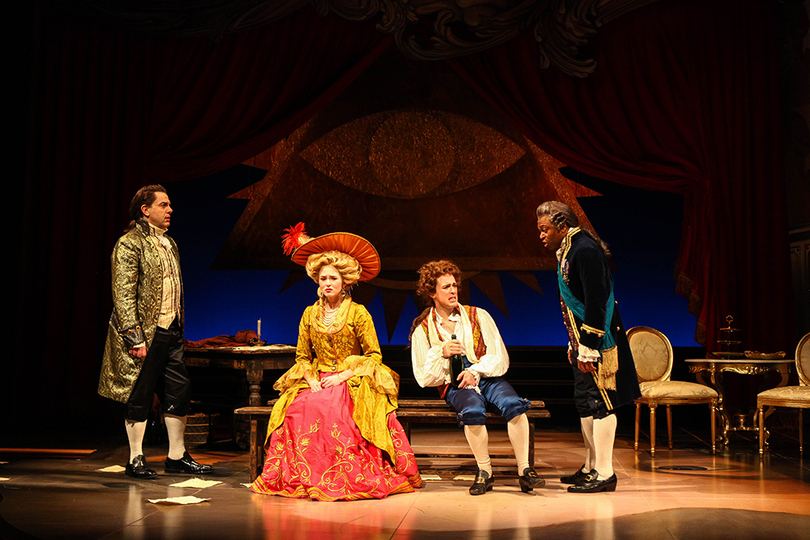Local theater companies adapt programming to pandemic guidelines

Courtesy of Syracuse Stage
Syracuse Stage’s last live performance was the opening night for Peter Shaffer’s “Amadeus ” on March 11 at the company’s Archbold Theater.
The Daily Orange is a nonprofit newsroom that receives no funding from Syracuse University. Consider donating today to support our mission.
As Syracuse University welcomes students back for the fall semester, local theater companies are left wondering when they will be allowed to invite audiences into their spaces.
Live performance venues, including music and theater, are still barred from opening under New York state’s COVID-19 restrictions. The 2020-2021 season will be anything but typical as companies from across Syracuse have to get creative with their programming.
“Every decision we’re making is being driven by a focus on the safety of our staff, the safety of our audience and the safety of our patrons,” said Bob Hupp, Syracuse Stage’s artistic director.
Syracuse Stage closed its doors on March 16, with limited staff members showing up, said Jill Anderson, Syracuse Stage’s managing director. By the beginning of April, production staff was creating personal protective equipment for front line workers instead of creating shows. It was only until recently that production staff could go back to work on building shows.
The theater also didn’t lay off any workers and focused on employees keeping their jobs throughout the COVID-19 pandemic, Hupp said.
“Unlike just about every other theater in the country, we didn’t lay anybody off,” Hupp said. “(We are) making sure that they can work remotely, but (Syracuse Stage’s employees) are able to get a paycheck from Syracuse Stage and stay employed. That’s something that’s been a priority for us.”
Syracuse Stage’s last live performance was the opening night for Peter Shaffer’s “Amadeus,” directed by Hupp, on March 11 at the company’s Archbold Theater. Luckily, “Amadeus” was filmed, and Syracuse Stage was able to offer the show as a webcast, charging patrons $35 to experience the play virtually.
The response to the stream was unanimously positive, Hupp said. Despite the theater being based in New York, people from 47 states and four countries watched “Amadeus,” he said.
Virtual experiences have kept patrons interested. The company’s “Cold Read Series,” which in the past has sold around 100 tickets, was attended by three times as many patrons when it was held in March, Hupp said.
The education content has had a similar reach, with non-local middle school students who wouldn’t normally be able to attend now able to participate online, Anderson said.
Syracuse Stage has been working with Onondaga County and SU to see how people could safely come and watch a show in Archbold Theater, Hupp said. Ideas include cutting intermissions from shows and getting rid of the concession stands, but Hupp believes that won’t be for another four to five months.
For actors, Hupp plans for shows to begin rehearsing virtually. He also plans for the theater to create an “NBA style bubble” and make sure that they test everyday.
The theater has worked with other regional theaters venues to create a standard protocol, Anderson said.
“(We’re) thinking about ways to ensure that if a patron comes to a live event at any of our spaces, the protocols are either the same or thoughtfully divergent,” Anderson said. “Statistics show people who support one arts organization tend to support two, three, multiple across the region.”
Redhouse Arts Center was also forced to cut a show short, ending its production of August Wilson’s “Fences” in March and pivoting to streaming content. Instead of live performances, Redhouse produced a play that took place entirely on Zoom. The theater also offered online educational programs, just like Syracuse Stage.
In July, Redhouse invited students ages 6 to 18 back into the building for in-person learning and used social distancing and masks to limit the threat of COVID-19.

Using creativity during a time which needs it, Redhouse Arts Center produced a play that took place entirely on Zoom. Courtesy of Redhouse Arts Center
Samara Hannah, Redhouse’s executive director, said that, while some education has been able to continue in-person, the theater is far from ready to invite actors back into the space. She anticipates a return to live performance sometime next year, but she stresses that continuous testing and other protocols are needed to safely return to normal operation.
“The goal is to get back into live theater,” Hannah said. “(But) it’s situational, and you know, really the lives of people is the top priority and what we are focused on.”
Nicholas MacLane, an actor, director and designer who works with Central New York Playhouse, said that, as a performer, he would be comfortable returning to the stage once it was deemed safe by local officials.
He hopes for shows to be shorter so that he and other actors can stay safe.
“I don’t know at what point I’d be comfortable doing a whole two and a half-hour show,” MacLane said. “I think for a while we’re gonna see smaller cast sizes.”





